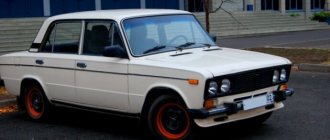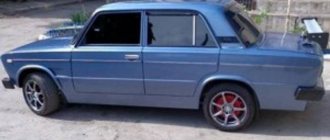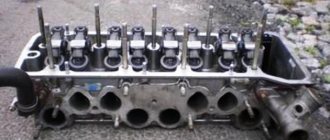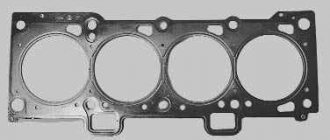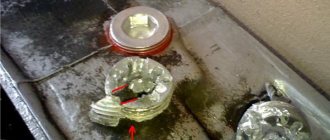How many kg of aluminum are in the VAZ 2106 engine?
How we are working
| VAZ model | Car weight | Blockage |
| 2105 | 955 kg | 30% |
| 2106 | 1045 kg | 30% |
| 2107 | 1060 kg | 30% |
| 2109 | 945 kg | 30% |
Interesting materials:
What is the difference between cabbage soup and green borscht? How to remove hair dye from a case? How to remove soap stains on glass? How to clean the outside of a stainless steel kettle? How to clean the floor from silicone? How to clean silicone from the toilet? How to remove sticker marks? How to clean the inside of a thermos from tea? How to remove iodine from clothes? How to remove red wine from white jeans?
How much does a VAZ classic cylinder block weigh?
VAZ cylinder block sizes: 2103, 2106, 21213, 21214, 2123, 2130.
Applicability - on engines: VAZ-2103, 21043, 21053, 21061, 2107.
What size piston rings for VAZ 2103:
How much does the VAZ 2106 engine block weigh? — Weight — 39,200 kg.
Applicability - on engines: VAZ 2106, 21067, 21074, 2121 Niva.
Applicability - on engines: VAZ 21213, 21073, 21214.
Applicability - on engines: VAZ 21214, 21073, 21213.
Applicability - on engines: VAZ 2123.
Applicability - on engines: VAZ 2130.
All of the above blocks are used on engines that belong to the line of “classical” design engines.
All these cylinder blocks share the same dimensions:
— the distance between the axes of adjacent cylinders, which is 95.00 mm;
— diameter of the bed for the crankshaft supports.
The table shows the main dimensions of VAZ cylinder blocks. (block repair dimensions)
| Cylinder block model | Dc(mm) | H(mm) | Lc(mm) | d(mm) |
| VAZ 2101 * | 76.00 +0,05 | 207.10 -0,15 | 95.00 | 54.52-0,013 |
| VAZ 21011 * | 79.00 +0,05 | 207.10 -0,15 | 95.00 | 54.52-0,013 |
| VAZ 2103 | 76.00 +0,05 | 215.90 -0,15 | 95.00 | 54.52-0,013 |
| VAZ 2106 | 79.00 +0,05 | 215.90 -0,15 | 95.00 | 54.52 -0,013 |
| VAZ 21213 | 82.00 +0,05 | 214,58 -0,15 | 95.00 | 54.52 -0,013 |
| VAZ 21214 | 82.00 +0,05 | 214,58 -0,15 | 95.00 | 54.52 -0,013 |
| VAZ 2123 | 82.00 +0,05 | 214,58 -0,15 | 95.00 | 54.52 -0,013 |
| VAZ 2130 | 82.00 +0,05 | 215.90 -0,15 | 95.00 | 54.52 -0,013 |
* - discontinued by JSC AVTOVAZ
DC
— Cylinder diameter of the VAZ block;
H
— The distance between the upper plane of the block and the axis of the crankshaft (height of the VAZ block);
Lc
— Distance between the axes of adjacent cylinders of the block (inter-cylinder distance);
d
— The diameter of the boring of the crankshaft supports (for the main bearings).
Based on the results of final processing of the surface of the cylinders, depending on the diameter dimensions, a cylinder size class is assigned. There are five size groups defined for cylinders, which are designated by letters: A, B, C, D, E. Cylinder class
applied to the surface of the block, opposite each cylinder. For each nominal cylinder diameter, its own size classes are adopted.
| Class | A | B | C | D | E |
| Cylinder diameter 76 (mm), | 76,000-76,010 | 76,010-76,020 | 76,020-76,030 | 76,030-76,040 | 76,040-76,050 |
| Cylinder diameter 79 (mm), | 79,000-79,010 | 79,010-79,020 | 79,020-79,030 | 79,030-79,040 | 79,040-79,050 |
| Cylinder diameter 82 (mm), block: VAZ 21213, VAZ 21214, VAZ 2123, VAZ 2130. | 82,000-82,010 | 82,010-82,020 | 82,020-82,030 | 82,030-82,040 | 82,040-82,050 |
For a cylinder with a certain class, a piston of the corresponding class is selected.
Control of the diameter and wear of the surface of the cylinders is carried out using a device - a bore gauge.
Measurements are taken at the level of several belts, in mutually perpendicular directions. In the upper part of the cylinder, at a distance of no more than 5 mm from the upper plane of the block, there is an area where there is no wear and the size corresponds to the nominal diameter of the cylinder. If in one of the other control sections of the cylinder, size deviations exceeding 0.15 mm from the nominal are detected, then it is necessary to bore the cylinders of the block, followed by honing them to the nearest repair size. Depending on the operating conditions of the engine and compliance with technical requirements, the need for cylinder boring may arise after 120 - 250 thousand km. vehicle mileage.
To increase the service life of the blocks, two repair sizes have been determined for each of the nominal cylinder diameters. Each repair size
differs from the previous size by 0.4 mm. The table shows the repair dimensions of the block cylinders, their intermediate dimensions for boring and honing.
Repair sizes of pistons of the corresponding class are selected for repair sizes of cylinders. As a result, a gap of 0.05-0.07 mm between the cylinder and the piston is achieved.
Source
In what models was the VAZ used?
Improved engine characteristics made it possible to equip them with VAZ cars of the following models:
- 2103 Lada sedan;
- 21054 Zhiguli sedan (only for the FSB, the Ministry of Internal Affairs and the State Traffic Safety Inspectorate);
- 2106 Lada sedan;
- 21074 Lada sedan;
- 2121 Niva carries a 5-door station wagon or a 3-door hatchback.
Due to the following difficulties in the production of some parts, the 2106 engine was considered economically unprofitable by management and was discontinued.
What engines can be installed on the VAZ 2106?
The best solution is to leave the one you have. However, some craftsmen install other units. You need to remember that the hood of this car is small in size. Therefore, VAZ 2106 engines with a cylinder diameter of 79 ml will feel most comfortable. You cannot install units that are too powerful, since neither the brake system, nor the axle, nor the suspension will be able to service them. It is recommended to install the following models:
- from Fiat 124
- from BMW 536, BMW 326, BMW 746
- model Lancia Thema (834)
- Alfa Romeo model (06476)
- Fiat Croma model (154)
In any case, it will be necessary to make some modifications related to the design features of each model.
Injection modification
The first in the line of internal combustion engines from the manufacturer AvtoVAZ, the 2106 engine received tuning in the form of distributed injection. At the same time, the owners got a headache:
- intense heating, since the mixture is scarce, the manufacturer’s cooling system cannot cope with temperature loads;
- increase in fuel consumption to 13 l/100 km in winter.
A positive point is the small budget for major repairs, within 10,000 rubles.
Disadvantages and advantages
The 2106 engine has significant disadvantages:
- excess heat is removed in the piston crown well and in fins with steel adjusting plates inside the studs;
- dynamic loads are reduced due to the displacement of the finger to the right from the axis of symmetry;
- When assembled into an engine, the pistons are installed with markings in one direction, which increases labor costs and human error.
The internal combustion engine uses a model 2103 cylinder head, a 35.3708 starter and a G221 generator for a 42A engine. Oil consumption does not exceed 700 g / 1000 km. The operating instructions indicate that it is recommended to add 200 ml of lubricant less than the volume of the entire system. Markings for filling oil are shown in the table above.
Technical features
Characteristics of the VAZ 2106 engine:
- The cylinder block is made of cast iron
- Can work with both carburetor and inverter type power systems
- The engine cylinders are in-line
- There are 4 cylinders in total
- There are 2 valves on the cylinder
- The distance from the lower to the upper position of the piston is 80 millimeters
- Each cylinder has a diameter of 79 millimeters
- The compression ratio of the unit is 8.5 atmospheres
- The power of the VAZ 2106 engine is 75 horsepower
- Engine displacement – 1,569
- You can use AI92 gasoline
- For every 100 kilometers on the highway, consumption averages 7.4 liters, and in the city - 10 liters
- For every 1000 kilometers, 700 grams of oil are consumed
- The following types of oil can be used: 5w-30, 5w-40, 10w-40, 15w-40
- When changing oil you need to use 3.5 liters
- According to factory data, the unit can travel up to 125,000 kilometers. In fact, it works up to 200,000 kilometers
- Installed on both VAZ 2106 and VAZ 21074, as well as VAZ 2121, VAZ 21053, VAZ 2103.
- Candles should be used of the following type: A17DVR, A17DV-10, FE65CPR
- The weight of the VAZ 2106 engine is 121 kilograms
Engine tuning
Since the engine has no modifications, the main tuning is to improve the existing characteristics. Basic operations:
- installation of a 16-valve cylinder head - allows you to increase power by 17 - 21%;
- modernization of the crankshaft - lightening the connecting rods, crankshaft and pistons, grinding the manifold;
With a minimum budget, tuning usually consists of upgrading the carburetor:
- primary chamber - disassembling the spring to increase the sensitivity of the unit;
- secondary chamber - the vacuum design is converted into a mechanical one using a piece of wire.
It is important not to forget which oil the manufacturer recommends and the timing for replacing consumables.
Therefore, the 2106 engine is one of the “millionaires” in terms of maintainability of cylinders and piston assembly, crankshaft, interchangeability of crankshafts and camshafts of the VAZ engine family.
Related posts:
- Fan in the interior lighting viburnum
- Liquid locker nippon ace reviews
- Replacing the Niva front axle drive oil seal
- The best piston rings for the VAZ 2110
| 1) adjust the ignition, check the oil level, replace the liners, tighten the flywheel bolts | |
| Low oil pressure when engine is hot | 1) wear of oil pump gears |
| 1) unit repair | |
| Increased fat intake | 1) leaking gaskets |
| 1) replacement of consumables | |
| Increased gasoline consumption | 1) the damper opening angle has been reduced |
| 1) damper adjustment | |
| Reduced throttle response and reduced power | 1) pump failure |
| 1) pump repair |
Maintenance Procedure
The classic internal combustion engine device allows you to perform simple actions when servicing the engine:
| Valve seat | width 2 mm, angle 45° |
| Camshaft | upper inside cylinder head, phase width 232°, exhaust valve advance 42°, intake valve retard 40° |
| Camshaft oil seal | diameters - 40 mm, 56 mm, width 7 mm |
| Cylinder block material | cast iron |
| Cylinder diameter | class A - 79 - 79.01 mm |
| Pistons and rings | Tinned aluminum alloy piston |
| Piston diameter | class A - 78.94 - 78.95 mm |
| Liquidation | piston / cylinder wall - 0.153 - 0.173 mm (standard) or 0.19 mm (maximum) |
| Upper compression ring | 1535 - 1555 mm |
| Bottom compression ring | 3.957 - 3.977 mm |
| Oil scraper ring | 2015 - 2035 mm |
| Gap between piston groove and ring | 0.03 - 0.07 mm |
| Motor shaft | cast iron, casting |
| Number of main bearings | 5 |
| Gear journal diameter | 50.795 - 50.775 mm |
| Major revised resolution | 0.1 - 0.5 mm |
| Connecting rod bearings | shaft pin diameter - 47.814 mm |
| Crankshaft oil seal | front - diameters 42 mm, 60 mm, width 7 mm |
| Piston stroke | 80 mm |
| Fuel | AI-92 |
| Environmental standards | Euro 2 |
| Fuel consumption | highway - 7.8 l / 100 km |
| Oil consumption | no more than 0.7 l / 1000 km |
| Oil for 2106 | 5W-30 – 15W-40 |
| Engine oil volume | 3.75 l |
| Replacement frequency | every 55,000 km |
| Working temperature | 80° |
| Motor resource | stated 120,000 km |
| Valve adjustment | nuts and dipstick |
| Cooling system | forced |
| Refrigerant quantity | 9.85 liters |
| water pump | polymer impeller, block mounting |
| Turn on | distributor |
| Spark plugs for 2106 | A17-DVR, FE65CPR, A17DV-10 |
| Gap between spark plug electrodes | 0.5 - 0.6 mm |
| Valve circuit | double-row roller, 114 links |
| Cylinder order | 1-3-4-2 |
| Air filter | drying with replaceable cardboard cartridge and pre-filter, temperature adjustment depending on the season |
| Oil filter | recommended Mann W914/2 |
| They're flying | 129 teeth, 0.62 kg |
| Flywheel bolts | 10x1.25 mm, length 23.5 mm, |
| Valve stem seals | Manufacturers Horse or Corteco |
| Compression | cylinder pressure from 10 to 14 bar, pressure drop in individual cylinders within 1 bar |
| Oil temperature | 80°C |
| Thermostat temperature | 80 - 84 ° C |
| Pressure valve inside the radiator cap | 0.7 - 1 bar |
| Contains in the release of harmful products | CH-1 |
| Clamping force of threaded connections | spark plug - 31 - 39 Nm |
| Service element | Time or mileage (whichever comes first) |
| Timing belt | replacement after 100,000 km |
| Battery | 1 year / 20,000 |
| Valve clearance | 2 years / 20,000 |
| Crankcase ventilation | 2 years / 20,000 |
| Belt guide accessories | 2 years / 20,000 |
| Fuel line and tank cap | 2 years / 40,000 |
| Engine oil | 1 year / 10000 |
| Oil filter | 1 year / 10000 |
| Air filter | 1-2 years / 40,000 |
| Fuel filter | 4 years / 40,000 |
| Heating/Cooling Fittings and Pipes | 2 years / 40,000 |
| Coolant | 2 years / 40,000 |
| Oxygen sensor | 100 000 |
| Candle | 1-2 years / 20,000 |
| Exhaust manifold | 1 year |
As the effective life of an internal combustion engine increases, consumables can be replaced more often than the specified periods, or operations for cleaning the carburetor, engine, jets and other accessories can be added.
Typical faults and features
If you know the features of the motor used in your personal car, you can significantly extend its service life and maintain good performance. Therefore, we will consider the most typical aspects that relate to this unit.
Warming up . In winter, the engine needs to be warmed up. You need to wait at least five minutes until the speed increases to 1500 rpm. Once the idle starts to hold up well, you can hit the road.
Oil . As for oil, problems often arise due to excessive savings. Owners of the “six” often buy low-quality oil or do not replace it in a timely manner. This leads to the fact that after a mileage of 60 thousand kilometers, the cylinders may increase in diameter. Also, sometimes situations arise that the engine begins to consume too much oil - more than 1 liter for every thousand kilometers. This indicates that it is time to measure the compression. This will let you know if there is a problem with the rings or valves.



